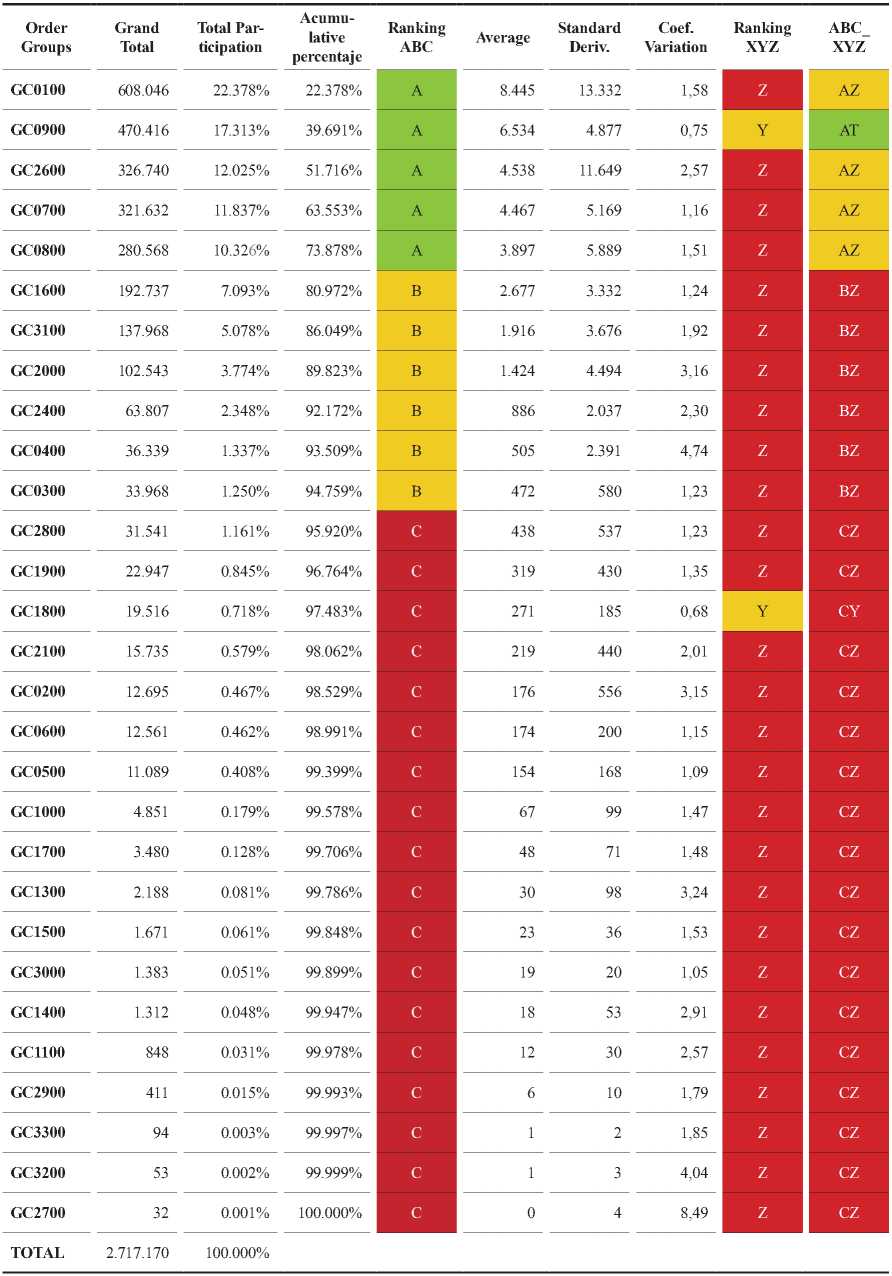
Ship Science & Technology - Vol. 16 - n.° 31 - (42-60) July 2022 - Cartagena (Colombia)
DOI: https://doi.org/10.25043/19098642.234
Jorge Grosso1
Susan Ruiz 2
José Carrasco 3
1 Universidad Escuela Naval de Cadetes “Almirante Padilla”. Cartagena, Colombia. Email: jorgegrossocastro@gmail.com
2 Universidad Escuela Naval de Cadetes “Almirante Padilla”. Cartagena, Colombia. Email: susan.natalia@hotmail.com
3 COTECMAR. División de adquisiciones. Cartagena, Colombia. Email: jcarrasco@cotecmar.com
Date Received: March 5th, 2022 - Fecha de recepción: 5 de marzo de 2022
Date Accepted: July 15th, 2022 - Fecha de aceptación: 15 de julio de 2022
This research paper is a historical analysis of repair and maintenance purchases for the Corporation of Science and Technology for the Development of the Naval, Maritime and Fluvial Industry - COTECMAR. More precisely, to the projects from Planta Bocagrande. This analysis, searches for aspects to reduce the uncertainty gap in the purchases, through strategic measures, which facilitate the procurement process. The research model is based on the historical data analysis from purchases between 2015 and 2020. It also applies the ABC-XYZ classification, the Kraljic matrix and the criticality levels of the products. The research presents conclusions and recommendations according to the results from the classification and selection of the most relevant materials or products within the purchasing group, chosen following Pareto's law. Considering that the repair and maintenance business line is a market with high uncertainty and variability, adequate planning is required to improve the competitiveness of the services provided to regional shipyards, as a sample of the effectiveness of the capabilities developed by the Colombian shipbuilding industry.
Key words: Analysis, historical behavior, uncertainty, purchases, shipyards, repair, maintenance, products.
Este documento de investigación se presenta como un análisis del comportamiento histórico de compras en los proyectos de reparación y mantenimiento en la Corporación de Ciencia y Tecnología para el Desarrollo de la Industria Naval, Marítima y Fluvial — COTECMAR, más específicamente para los ejecutados en la Planta de Bocagrande. El anterior análisis, se centra en la búsqueda de aspectos que reduzcan la brecha de incertidumbre en las compras, mediante estrategias que faciliten la planeación de las compras. El modelo de investigación está basado en el análisis histórico de las compras por medio de la clasificación de los grupos y productos adquiridos en el periodo de 2015 hasta el 2020 teniendo en cuenta la clasificación ABC-XYZ, la matriz de Kraljic y los niveles de criticidad de los productos. La investigación presenta conclusiones y recomendaciones acordes a los resultados obtenidos a partir de la clasificación y selección de los materiales o productos más relevantes dentro del grupo de compras, escogidos siguiendo la ley de Pareto. Teniendo en cuenta que la línea de negocio de reparación y mantenimiento es un mercado que presenta alta incertidumbre y variabilidad, se requiere una adecuada planeación que permitan mejorar la competitividad de los servicios prestados frente a los astilleros regionales, como muestra de la efectividad de las capacidades desarrolladas por la industria astillera Colombiana.
Palabras claves: Análisis, comportamiento histórico, incertidumbre, compras, astilleros, reparación, mantenimiento, productos.
In relation to its mission and vision, and in the improvement of its strategic plan, The Corporation of Science and Technology for the Development of the Naval, Maritime and Fluvial Industry (COTECMAR), in recent years has implemented strategies to strengthen the attention and satisfaction of its main customer: the National Navy; as well as the reactivation of private customers, in order to further strengthen relations with them, and in turn achieve a better position to its future customers (Arcieri, 2014).
Inventory and purchasing management is considered one of the most complex logistical aspects, since the large investments involved in inventories and the need to control the inventory capital associated with raw materials, product in process and finished product, is perceived as a potential area to contribute to the improvement of the entire supply chain (Axsäter, 2000).
A common problem in inventories is the existence of surpluses and shortages, better known as inventory imbalance, which according to Vidal (2006): "We always have too much of what is not sold or consumed and too much of what is sold or consumed". Inventories are made necessary by random fluctuations in demand and lead times and by the mismatch generated between the demand of end consumers and the production or supply of the products requested (Juan Miguel Cogollo, 2011). Similarly, procurement management requires strategies to anticipate clients' needs and thus guarantee better conditions in terms of cost and delivery time. In order to establish such strategies, the Corporation's purchasing databases make it possible to identify possible patterns in purchasing management.
In this work, the historical behavior of COTECMAR's maintenance and repair purchases in the last five years for the Bocagrande Plant was analyzed to provide information on the possible correlation of purchases by groups of items in specific periods of time. Finally, some considerations that are expected to optimize the logistical support of the Corporation are also given.
For repair and maintenance projects executed by the Corporation of Science and Technology for the Development of the Maritime and Fluvial Naval Industry - COTECMAR to different clients, the demand for goods and/or services has critical time lines and its planning is limited by the urgency of the repair. For this reason, this type of projects need to identify strategies to anticipate the types of goods or services required.
COTECMAR in its Logistics Manual shows the conditions for support activities for repair projects: "For particular repairs, supply contracts, consignment and field services necessary to ensure continuity in repairs will be established, for this will continue with the strategies outlined in the supply matrix". (COTECMAR, 2016). However, these conditions do not contemplate the anticipation of purchases for the aforementioned maintenance and repair projects.
By performing an analysis based on historical purchases by purchasing groups, it will be possible to identify possible patterns over the last five years that have a significant correlation. This will make it possible to recommend measures to anticipate possible peaks in requirements and provide the Corporation with better cost and time conditions.
How has the Corporation of Science and Technology for the Development of the Maritime and Fluvial Naval Industry COTECMAR's purchases for the repair and maintenance projects of the Bocagrande plant behaved historically over the last five years?
Suppliers are the main allies that supply the necessary materials, allowing the development of the required projects, "To achieve the success of an organization includes the selection and management of suppliers of goods and services, the negotiation of prices and purchase terms, and the acquisition of quality goods and services" (PILOT, PricewatheratherouseCoopers., 2008). The performance of suppliers and of the supply chain in general is determined by the ability to meet demand. Therefore, anticipating demand means an improvement in the conditions for the supply of goods and services, and therefore, an improvement in the capacity to meet projects.
Having tools to improve purchasing processes from the planning stage facilitates logistical support for projects, particularly repair and maintenance projects, and one of these tools is demand forecasting. Given the unpredictability of customer orders, demand management is a key element in effective supply chain management. During the demand management process, the customer's requirements must be balanced with the company's supply capacity by trying to determine what and when they will buy (forecasting). To reduce the level of uncertainty, demand management systems use the most important points of sale and customer databases, which can allow a better efficiency of the physical flow of goods along the supply chain (Jiménez & Hernández, 2002).
For repair and maintenance projects, the forecast of requirements is subject to a high level of uncertainty, which requires a flexible purchasing process. The above consideration is embodied in COTECMAR's logistics manual, "Taking into account the business dynamics, the model for COTECMAR's purchases and logistics, has as its main purpose to adapt to the changing environment of the Corporation, maintaining an organized and defined structure that expands or reduces according to the needs of the organization (High production scenarios and Low production scenarios)." (COTECMAR, 2016). This research presents a historical analysis of project purchases, in order to forecast eventual demand peaks in the purchasing processes for repair and maintenance projects.
COTECMAR in its logistics manual does not currently have tools and / or historical analysis, focused on forecasting requirements for repair and maintenance projects; however, it has enough information to perform such analysis and seek a competitive advantage, thanks to the ERP-SAP system. In COTECMAR this ERP system provides historical purchasing information (type of material, price, business unit, supplier, quantity, among others) since 2014, being currently a fundamental tool in all the processes of the Corporation, evidencing the following: "a company achieves a total competitive advantage in the market if it has an integrated information system throughout the organization, which monitors going through the chain from sales to purchase planning, through the analysis of demand, distribution and production". (PILOT, PricewaterhouseCoopers., 2008).
This research uses information collected and refined from the ERP regarding the purchases of COTECMAR's repair and maintenance projects, for analysis by date, purchase groups, frequency, among others. The results of the previous analysis are presented graphically showing the behavior of the purchases associated to the projects, during the last five years. The conclusion is the identification of the behavior of the groups of purchases for the repair and maintenance projects.
To analyze the historical behavior of COTECMAR's purchases of goods and services for the repair and maintenance projects at the Bocagrande plant in the last five years.
Compile information by groups of COTECMAR's purchases of goods and services for the repair and maintenance projects of the Bocagrande plant in the last five years.
Perform product classification, by means of the ABC/XYZ statistical tool, using purchase group history.
Analyze the main purchasing groups according to the ABC classification, based on historical behavior.
Select through the Kraljic Matrix the most representative materials of each group and classify them according to their level of criticality.
The methodology applied was the comparative-historical method, which deals with the "Procedure of investigation and clarification of cultural phenomena that consists of establishing the similarity of these phenomena, inferring a conclusion about their genetic kinship, that is, their common origin" (Bernal, 2010). (Bernal, 2010).
It consists of the collection of the information associated with the purchases of COTECMAR's repair and maintenance projects. This information is treated in order to eliminate possible noise in the data and have cleaner statistics. Likewise, the information was organized by the different groups of purchases, graphing the results obtained in different ways, and thus proceed with the analysis of possible correlation by applying the Pareto diagram and the ABC/XYZ analysis, which allows to know which items generate greater profitability to the company, the variation that they have in a given period and thus make better decisions regarding the supply of each one, which will allow to optimize inventories (Chackelson, 2010).
The research procedure is carried out by means of the historical-comparative method, which is the procedure of investigation and clarification of cultural phenomena that consists of establishing the similarity of these phenomena, inferring a conclusion about their genetic kinship, that is, their common origin. For this project, the following steps were applied to achieve the proposed objective:
Compilation and maintenance of information by groups of COTECMAR's purchases of goods and services for the repair and maintenance projects of the Bocagrande plant in the last five years.
Classification of products, by means of the ABC/XYZ statistical tool, using purchase group history.
Analysis of the main purchasing groups according to the ABC classification, based on historical performance.
Selection through the Kraljic Matrix of the most representative materials of each group and classification according to their level of criticality.
(Bernal, 2010), defines the population as "the set of all the elements to which the research refers." (p.160). When the set is very large, then we proceed to take a representative portion (sample), therefore, in this project we take as population the repair and maintenance projects of COTECMAR; then we take as sample the purchases of goods and services for the repair and maintenance projects in the Bocagrande plant in the last five years.
For this project, support was requested from the Corporation of Science and Technology for the Development of the Maritime and River Naval Industry (COTECMAR) who provided a document in which the history of purchases from 2015 to 2020 is reported, where the analysis and interpretation of this document was executed taking as a reference for the classification of purchases, Table 1: Purchasing Groups. Additionally, the collection of information through other sources of information such as official documents from public institutions, technical and research reports from public or private institutions, and other secondary sources such as books, articles, research papers.
Table 1. Procurement information by Purchase Groups. Analysis by purchasing groups from 2015 to 2020 for maintenance and repair projects. (ABC XYZ analysis and classification)
Once the information was acquired, a selection and debugging of data that was incomplete due to an inadequate digitalization of the information, and of some items that are not essential in the maintenance and repair processes, such as travel expenses, restaurant expenses, catering, lodging, among others, was carried out. To obtain the results, statistical techniques such as: Inferences, diagrams, correlations of variables, among others, were used to consolidate and graph the information in order to facilitate the analysis.
In the first instance, the information was concentrated by purchasing groups according to Table 1, summing by group, and integrating the number of units from 2015 to 2020. In addition, the share that each group represents among the total units purchased was identified. These groups of purchases correspond to a pre-established classification in COTECMAR, which associates each and every one of the purchases, under a group composed of similar purchases.
Knowing the participation that each group represents, it is analyzed by means of the ABC classification, which allows identifying the product groups with the highest order volume, generating a segmentation of the demand, which is evidenced by the Pareto Principle (Fig. 4) where approximately 20% of the groups represent 80% of the total purchases for the years 2015 to 2020.
Fig. 4. Frequency Polygon 1. Purchases PG GC0100.Note. Quantity of units purchased monthly from group GC0100 (Abrasives).
Source: COTECMAR. Own elaboration.
Fig. 1. Total Sharings per groups for 2015 to 2020.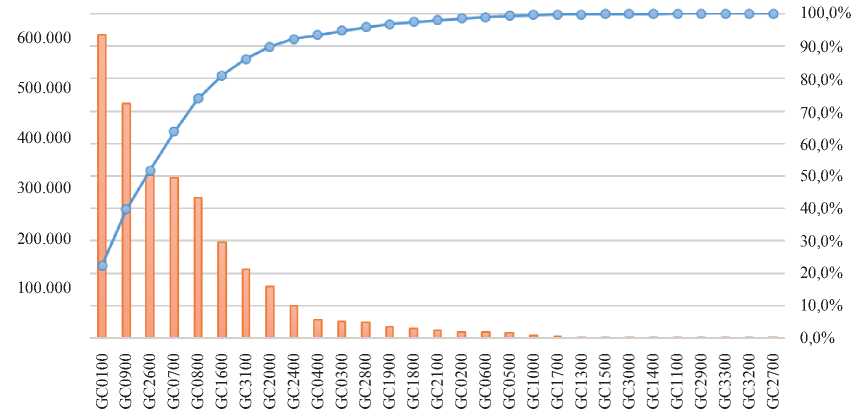
Source: COTECMAR. Own elaboration.
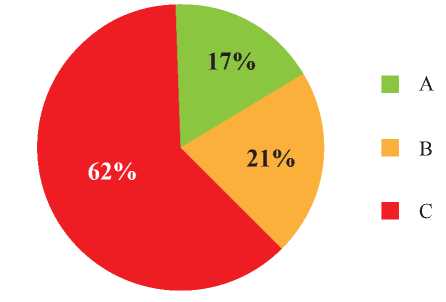
Source: COTECMAR. Own elaboration.
Fig. 3. Sharings in procurments by groups.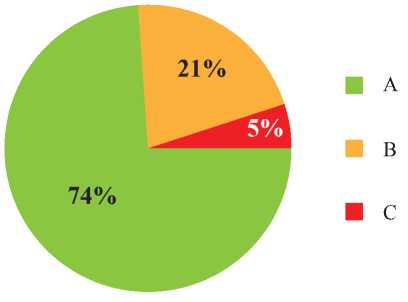
Source: COTECMAR. Own elaboration.
By means of the ABC classification (Table 2), a distribution of the groups in three sections is presented, as follows:
Table 2. ABC Classification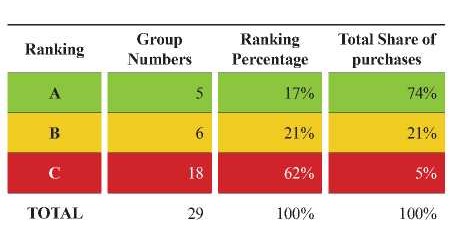
Note. ABC classification by total group and share of purchases.
Source: COTECMAR. Own elaboration.
Type A groups: there are five groups GC0100, GC0900, GC2600, GC0700, GC0800, which correspond to 17% of the total groups and account for 74% of total purchases.
Type B groups: there are six groups GC1600, GC3100, GC2000, GC2400, GC0400 and GC0300, which correspond to 21% of the total groups and account for 21% of total purchases.
Type C groups: there are 18 groups GC1600, GC3100, GC2000, GC2400, GC0400 and GC0300, which correspond to 62% of the total number of groups and account for 5% of total purchases.
The XYZ classification is used to approximately perceive the Volatility of the demand by calculating the Coefficient of Variation (CV= Deviation / Average CV= σ/μ = σ/d) where they are placed according to the following criteria:
Analyzes demand variability.
X: CV ≤ 0.5 (items with uniform demand)
Y: 0.5 < CV ≤ 1 (items with medium variance)
Z: CV < 1 (items with high variability)
Table 1 shows that most of the groups studied are in the "Z" range where the Coefficient of Variation is greater than 1, with the exception of groups GC0900 and GC1800, which belong to the "Y" set.
Taking into account the ABC classification, the analysis is focused on the groups categorized as "AZ" GC0100, GC2600, GC0700, GC0800, (purchases with a high volume of purchases and very unstable demand and high variability) and "AY" GC0900 (high volume of purchases, intermittent demand with medium variability), in order to focus the research on the groups of greatest interest.
Table 3. Demand per PG.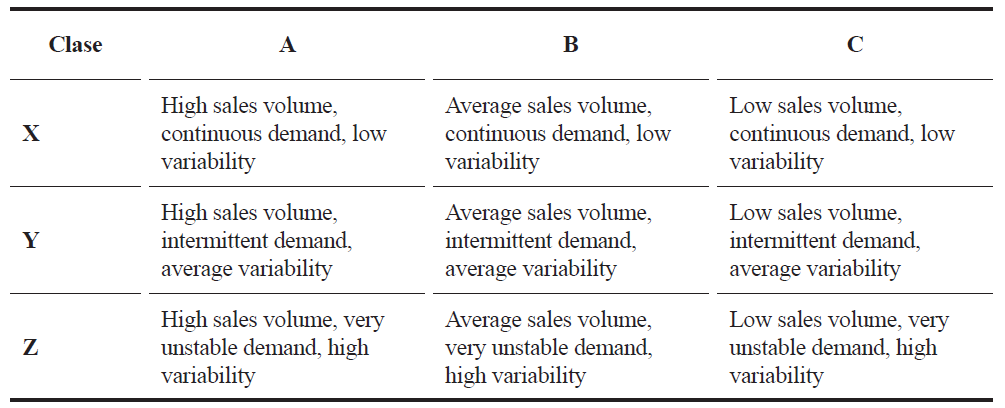
Note. own elaboration, based on (Krzyzaniak S., 2007) & (KaczorowskaZ., 2019) cited in (Żabińska, 2020).
Table 3. Purchases PG GC0100.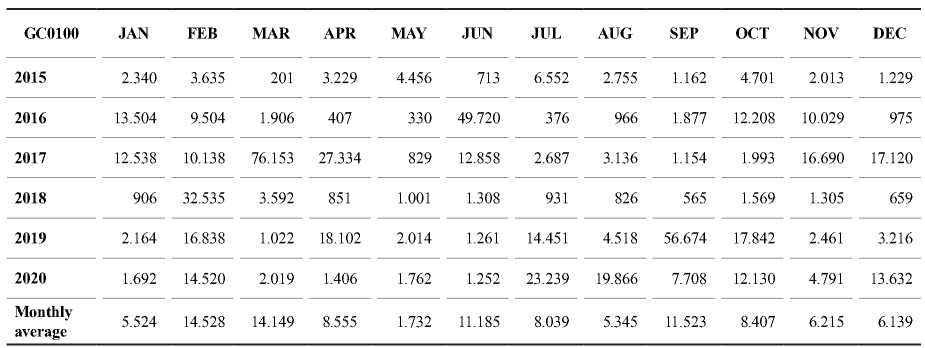
Note. Table of the quantity of units purchased monthly of group GC0100 (Abrasives).
Source: COTECMAR. Own elaboration.
With respect to the purchase group GC0100, by means of the Frequency Polygon 1 it can be evidenced that mainly three peaks are represented that exceed forty thousand units purchased the first one in June 2016, followed by March 2017 and finally September 2019, which generates a higher variation coefficient. Also, May is the month with the lowest average number of purchases (1,732) and uniform variability. In addition, in the months of February there is evidence of annual growth in purchases with an average variance with the exception of 2018 in which a peak is shown.
For the GC0900 group, it can be generally observed that it maintains a high volume of purchases with an average variability, although two peaks exceeding twenty thousand units purchased are highlighted, the first one in February 2015 and the second one in June 2016. In addition, for the months of October there is evidence of a smaller deviation in relation to the average.
The group GC2600 of welding articles and industrial gases through the previous Frequency Polygon reflects a high purchase volume with a high variability and an unstable demand. It also highlights a high volume purchasing behavior for the months of January and February accentuated with Greater relevance in the years 2015, 2016 and 2017 exceeding thirty thousand units purchased.
Table 4. Purchases PG GC0900.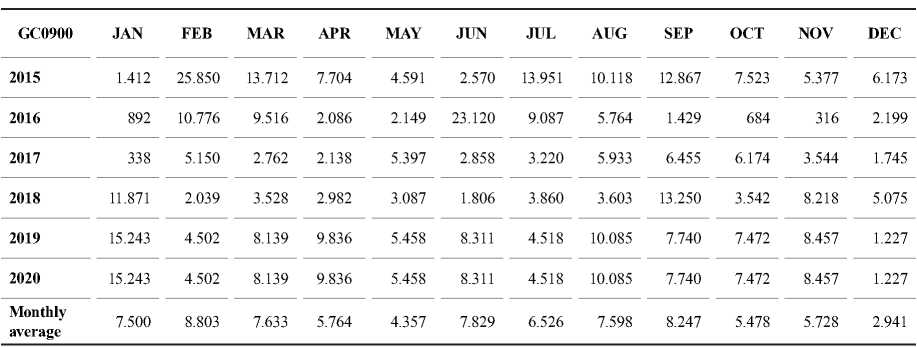
Note. Table of the quantity of units purchased monthly of group GC0900 (Abrasives).
Source: COTECMAR. Own elaboration.
Fig. 5. Frequency Polygon 2. Purchases PG GC0900.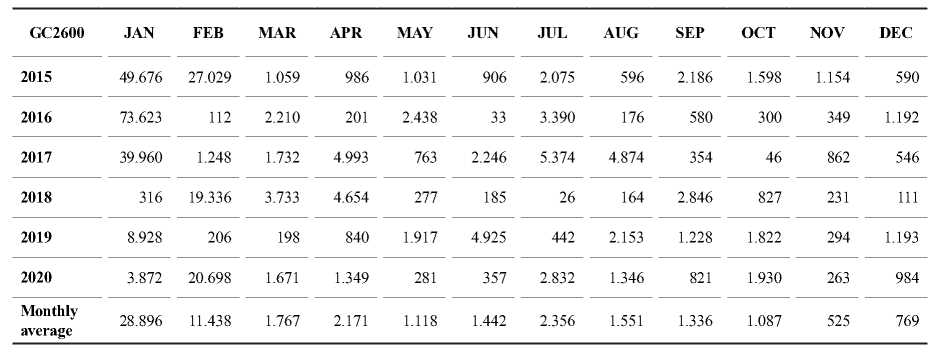
Note. Table of the quantity of units purchased monthly of group GC2600 (Welding and industrial gases).
Source: COTECMAR. Own elaboration.
Fig. 6. Frequency Polygon 3. Purchases PG GC2600.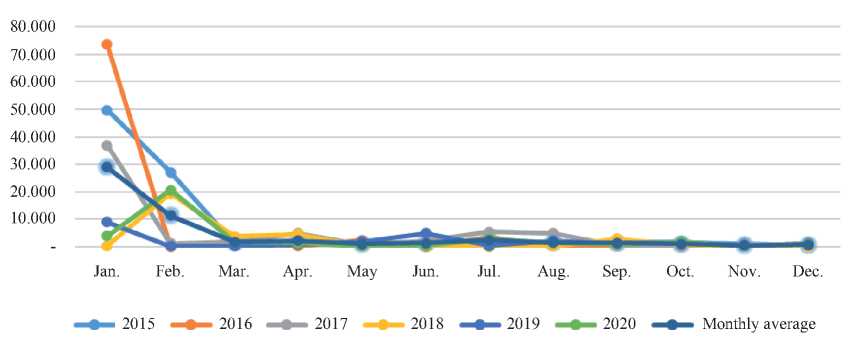
Note. Quantity of units purchased monthly from group GC2600 (Welding and industrial gases).
Source: COTECMAR. Own elaboration.
The GC0700 group shows a high volume of purchases, high variability and unstable demand (Frequency Polygon 4 and Table 6). It is worth highlighting a peak that exceeds twenty-five thousand units for the month of July in the year 20215 and a relationship between the five years for the months of December of these years shows the way in which variability decreases and the purchase volume does not exceed five thousand units.
Table 6. Purchases PG GC0700.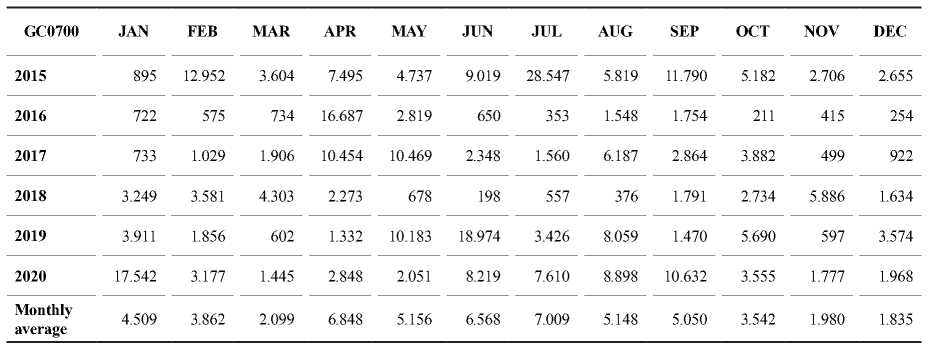
Note.Table of the quantity of units purchased monthly of group GC0700 (Electronic Elements).
Source: COTECMAR. Own elaboration.
In the purchase group GC0800 of Sheets and Anodes, there is a high purchase volume, high variability and unstable demand (Frequency Polygon 5). It is worth highlighting two peaks that exceed twenty thousand units of purchase, the first one in April 2017 and the month of August 2019. In addition, the month with the lowest level of purchase and the most uniform variability is the month of May at the general level for the years analyzed.
Fig. 7. Frequency Polygon 4. Purchases PG GC0700.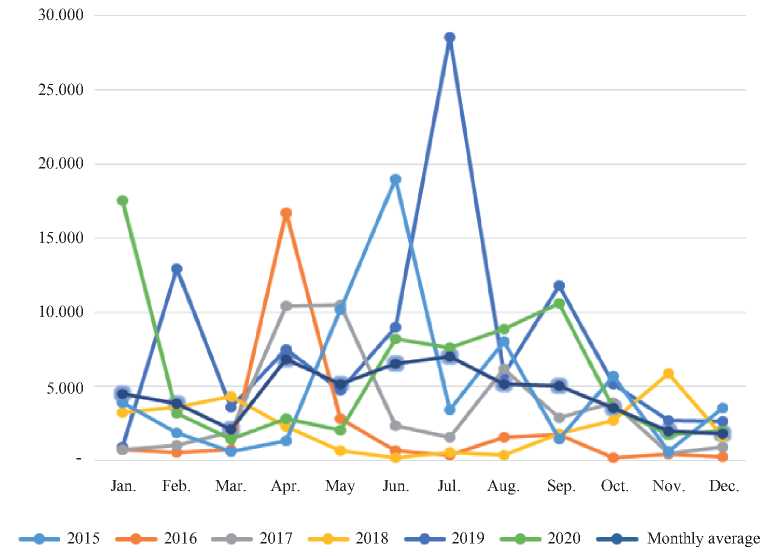
Note. Quantity of units purchased monthly from group GC0700 (Electronic Elements). Source: COTECMAR. Own elaboration.
Table 7. Purchases PG GC0800.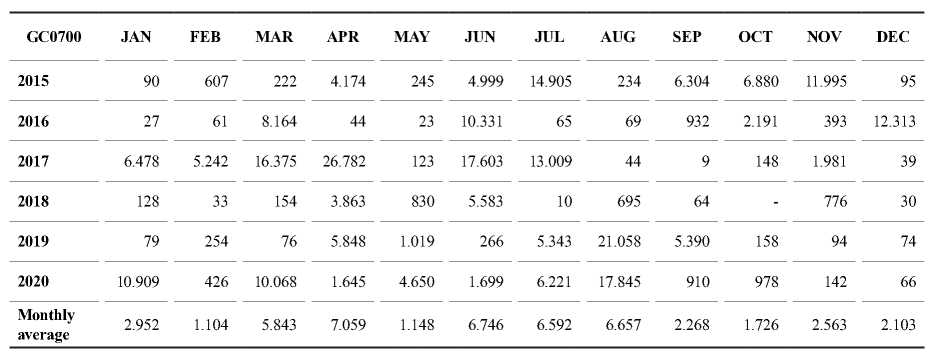
Quantity of units purchased monthly of the GC0800 group. Source: COTECMAR. Own elaboration.
Taking into account the ABC classification applied in the purchasing groups, the most representative materials of each of the groups were identified in order to identify the materials of greatest interest for COTECMAR's repair and maintenance projects.
Fig. 8. Frequency Polygon 5. Purchases PG GC0800.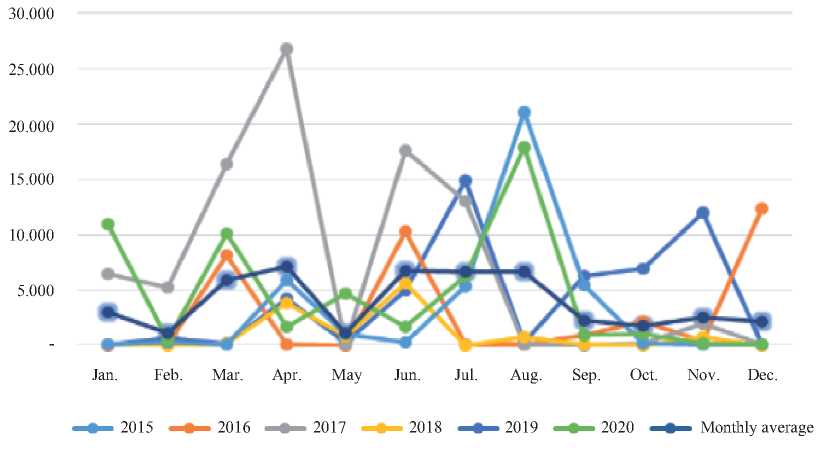
Note. Quantity of units purchased monthly of the GC0800 group. Source: COTECMAR. Own elaboration.
Table 8. Purchases PG GC0800.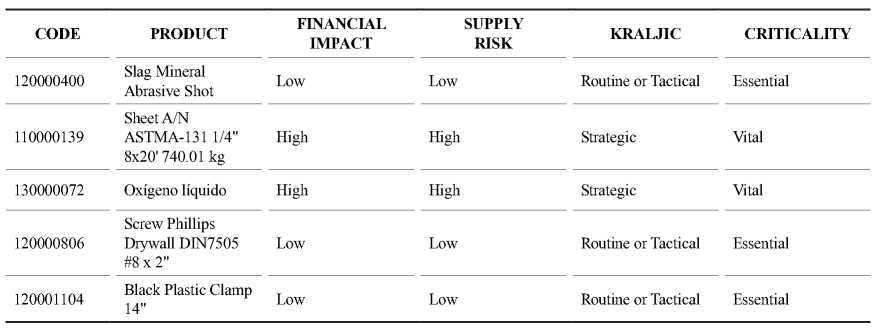
Note. Kraljic matrix of the most representative materials of each group and classification of criticality level.
Source: Own elaboration.
According to the frequency polygon 6, there are three representative purchasing peaks which exceed forty thousand units, the first one is in June 2016, the second one in March 2017 and the last one in September 2019. In addition, according to the Kraljic matrix, the material Slag Mineral Abrasive Shot is classified as a routine or tactical product, it also has a criticality of essential character generally for maintenance and repair and maintenance projects.
Fig. 9. Frequency Polygon 6. Purchases of material 120000400.
Note. Quantity of units purchased monthly in the last five years of Slag Mineral Abrasive Shot.
Source: COTECMAR. Own elaboration.
Table 9. Purchases for items of code 120000400.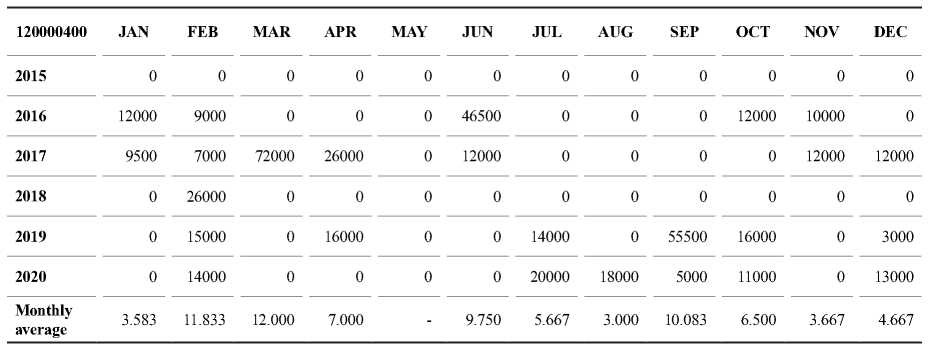
Note. Table of Quantity Units purchased monthly for items of code 120000400 (Slag Mineral Abrasive Shot).
Source COTECMAR. Own elaboration.
This product presents a high level of uncertainty, but has a considerable volume of units purchased in the second half of the last three years. In addition, according to the Kraljic matrix, we can see that this product is classified as strategic, and has a vital criticality characteristic within the maintenance and repair projects.
This material presents a purchasing behavior mostly inclined to the months of January and February with representative volumes. In addition, according to Kraljic's matrix, it is classified as a strategic material, and with a criticality characteristic of vital character within the maintenance and repair projects.
Fig. 10. Frequency Polygon 7. Purchases of material 110000139.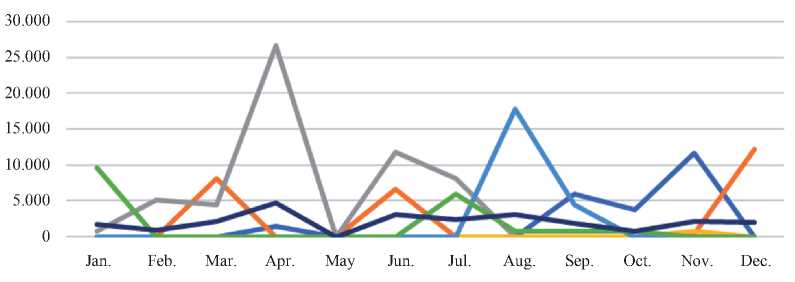
Note. Quantity of units purchased monthly in the last five years of ASTMA-131 1/4" 8X20' 740.01KG A/N ASTMA-131 sheet 740.01KG. Source: COTECMAR. Own elaboration.
Table 10. Purchases for items of code 110000139.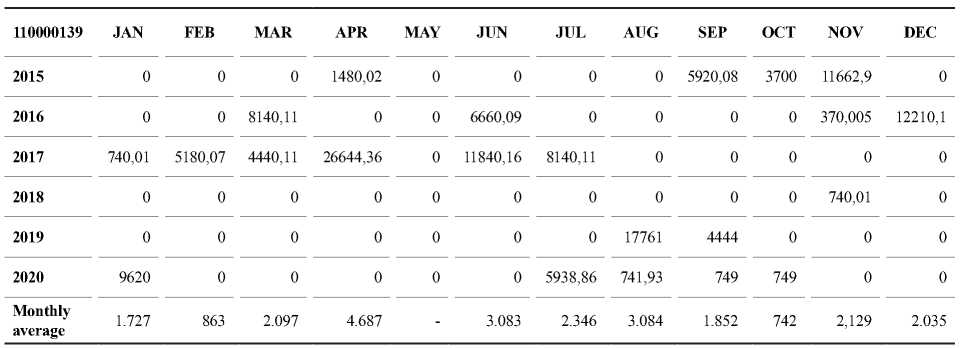
Note. Table of Quantity Units purchased monthly for items of code 110000139 (ASTMA-131 1/4" 8X20' 740 A/N ASTMA-131 sheet). Source COTECMAR. Own elaboration.
Fig. 11. Frequency Polygon 8. Purchases Items 130000072 Liquid Oxygen.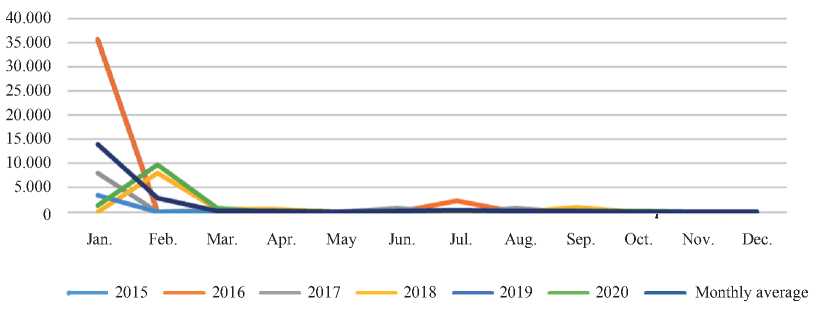
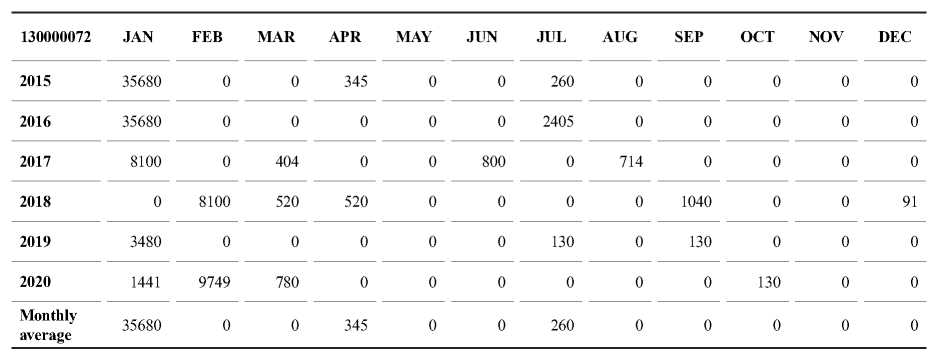
Note. Table of Quantity Units purchased monthly for items of code 130000072 (Liquid Oxygen).
Source COTECMAR. Own elaboration
This material, through the frequency polygon 9 shows us that it has a behavior focused on the second semesters of the years under study, and with peaks in 2015 for the months of March and July, in 2020 it presented a considerable growth in the second half of the year. In addition, according to the Kraljic matrix, this material is classified as routine or tactical, and a level of criticality denominated as essential within the maintenance and repair projects.
This reference, shows constant purchases with low volumes distributed in most months, and a large peak in 2019 for the month of June. In addition, it is classified according to the Kraljic matrix as a routine or tactical material, and a level of criticality denominated as essential within maintenance and repair projects due to the abundance of supply in the market.
Fig. 12. requency Polygon 8. Purchases Items 120000806.
Note. Table of Quantity Units purchased monthly for items of code 130000072 (Liquid Oxygen).
Source COTECMAR. Own elaboration
Table 12. Purchases for items of code 120000806.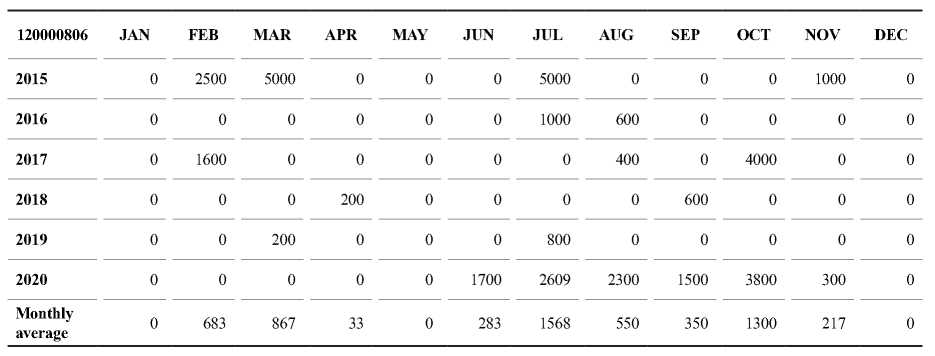
Note. Table of Quantity Units purchased monthly for items of code 120000806 (Drywall Screw Phillips Din7505 #8 X 2"). Source COTECMAR. Own elaboration.
Table 13. Purchases for items of code 120001104.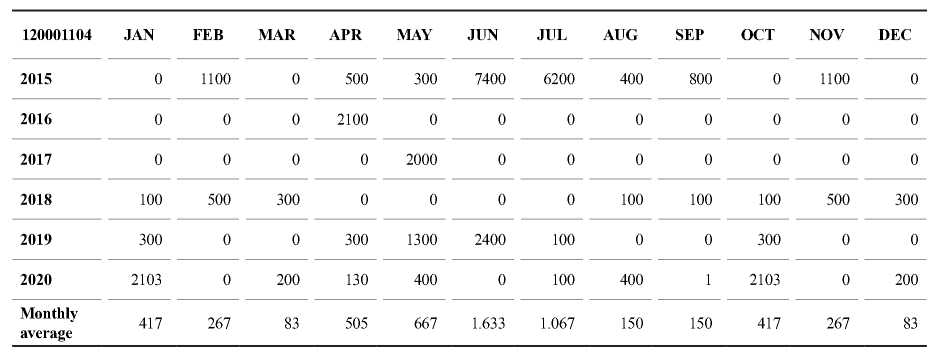
Note. Table of Quantity Units purchased monthly for items of code 120001104 (Black Plastic Clamp 14).
Source COTECMAR. Own elaboration.
In this work was performed, the analysis of the historical behavior of the purchases of goods and services of COTECMAR for the repair and maintenance projects Bocagrande plant in the years from 2015 to 2020, it was essential for this analysis to collect information by groups of purchases which was provided by COTECMAR; however, during the research it was evidenced that some data were wrong, reducing the accuracy of the results. Therefore, the importance of the adequate use of the information systems is highlighted, as well as the verification of the training of the personnel that manages them, and the standardization of the processes.
In addition, using the ABC/XYZ tool, evidence was obtained that the behavior of purchases follows the Pareto rule, where 17% of the purchasing groups have a share of 74% of the total number of units purchased, therefore, the demand for them is more relevant.
It was also ratified by means of the ABC/XYZ classification that these purchases highlight a behavior aligned to an uncertainty market, given that the volatility of demand could be perceived in an approximate way by means of the variation coefficient. For example, 93.1% of the groups are classified in the "Z" set, indicating high variability, and 6.9% in the "Y" set, indicating medium variability.
By means of the ABC classification, the behavior of the purchase history is analyzed, highlighting the importance of group "A", which contains groups GC0100, GC0900, GC2600, GC0700, GC0800, and therefore its behavior is analyzed graphically, concluding that there is a high variability and it does not show a marked seasonality of demand, nor a punctual and stable correlation in the years studied. However, it is necessary to carry out a more detailed follow-up by product to analyze each case in isolation and evaluate the characteristics that affect it.
In the case of group GC0100 (Abrasives), it was identified as the group with the highest participation, although it has a high variability, mainly characterized by purchases of more than ten thousand units in the month of February, so it is recommended as a minimum to make purchases for this month according to the average: 5,524 units. Also for the aforementioned group, a low level of purchases is observed in the month of May, with an average of 1,732 units, so it should be taken into account in the purchase planning. In addition, since this group has a high volume of purchases, the feasibility should be studied to generate alliances with suppliers that allow me the availability of products at a fair price.
One of the limitations found in the research was the large number of products, so the analysis was carried out by groups. However, it would be valuable for decision making to calculate the reorder points, time averages of average supply periods, storage costs, safety stock, among others, for each product that will allow you to have greater control over inventories. Within the most representative materials can be highlighted in each group according to Pareto's law as follows:
GC0100Abrasives - material 120000400 abrasive mineral slag abrasive grit
GC0800 Sheet and anodes - material 110000139 sheet a/n astma-131 1/4" 8x20' 740.01kg
GC2600 Welding items and industrial gases - material 130000072 liquid oxygen
GC900 Screws, nuts and washers - material 120000806 screw drywall screw Phillips din7505 #8 x 2".
GC0700 Electronic elements - material 120001104 black plastic clamp 14"
These materials are classified according to Kraljic's matrix as: routine or tactical (numbers 1, 4, and 5) due to the high levels of supply in the market or the ease of procurement and with an essential criticality level. And as strategic (numerals 2 and 3) due to their high procurement risks and high financial costs and with a vital criticality level due to the importance in maintenance and repair projects.
ARCIERI, J. (2014). Implementation of Strategies to Strengthen the Attention and Satisfaction of the National Navy Customer and Reactivation of Private Customers.
AXSÄTER (2000). Inventory Control. 2-5. Boston: Kluwer Academic Publishers.
Bernal, C. (2010). Metodología de la Investigación 3edición Bernal. Bogotá DC, Colombia: Pearson Educación de Colombia Ltda.
COGOLLO, J., OTERO, M., HERNÁNDEZ, J., ANGULO, A., SALAZAR, C., & ZULUAGA, J. (2011). Development Of A Logistic Model That Allows The Increase Of Competitiveness In COTECMAR.
COTECMAR. (2016). Logistics Manual. Cartagena.
CHACKELSON, C. (2010). Validation of an expert system to improve inventory management through case studies. UM Journals Engineering Research.
JIMÉNEZ, J., & HERNÁNDEZ, S. (2002). Supply chain framework. Retrieved from https://www.imt.mx/archivos/Publicaciones/PublicacionTecnica/pt215.pdf
PILOT, Pricewatherousecoopers (2008). Reference manual - Procurement Management. Retrieved from https://repository.unad.edu.co/bitstream/handle/10596/5649/207115%20Logistica.pdf;jsessionid=45E0BB2A191DDD 5D677CE1313B63095FA.jvm1?sequence=1
VIDAL, C. Introduction to inventory management. Universidad del Valle, School of Engineering, School of Industrial Engineering and Statistics. Cali. 2006. pp.1- 16.